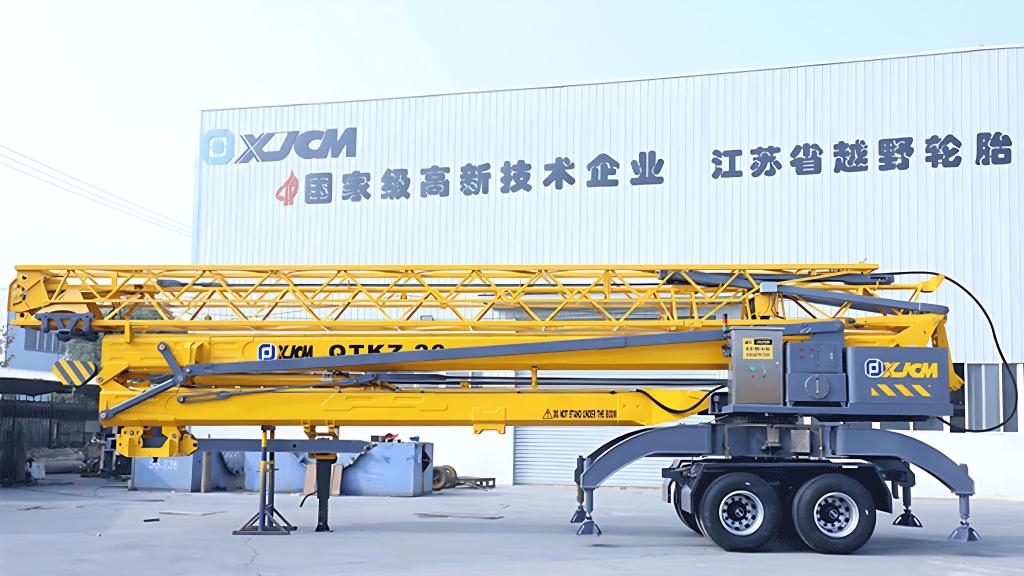In modern construction, selecting the right crane can significantly impact project efficiency, safety, and costs. Among popular options are fast-erecting cranes and self-erecting cranes—both designed to optimize lifting operations but suited to different project needs and environments.
This article provides a detailed comparison between these two types of cranes, helping you understand their features, setup times, mobility, and operational advantages. For compact or medium-scale construction projects that require frequent repositioning and moderate lifting, knowing the differences will guide you in selecting the crane that optimizes both efficiency and cost.
Understanding the Basics
Comparison of Key Features
| Feature | Fast Traction Tower Crane | Small Self-Erecting Tower Crane |
|---|---|---|
| Max Hoisting Height | Around 24 meters | 16–23 meters |
| Max Working Radius | Around 26 meters | 18–37 meters |
| Max Hoisting Weight | Approximately 2 tons | 1–4 tons |
| Erecting Time | About 10 minutes | About 6 minutes |
| Outrigger Span | Approximately 4.2 x 4.2 meters | Approximately 3.5 x 3.5 meters |
| Max Travel Speed | Up to 80 km/h (on rails) | Around 15 km/h |
| Power Supply | Standard 380V/50Hz | Around 13.9 kW total power |
What Are Fast-Erecting Cranes?
A fast erecting crane is designed for rapid setup using hydraulic assistance, usually completing the process in around 10 minutes. These cranes can be towed or travel on rails, making them suitable for mid-sized construction projects that require frequent repositioning and efficient material handling.
What Are Self-Erecting Cranes?
A self erecting tower crane assembles itself using integrated hydraulic and electric systems without needing auxiliary equipment. Due to their compact design, self erecting tower cranes are ideal for residential or commercial builds in space-constrained urban environments.
Setup Time Comparison
Fast-Erecting Cranes: Speed with Assistance
Fast-erecting cranes can be set up in approximately 10 minutes using hydraulic controls and remote operation. However, towing setups or rail installation are typically required in advance, making them better suited for prepared construction environments.
Self-Erecting Cranes: Autonomous Efficiency
Self-erecting cranes generally set up faster, around 6 minutes, without external equipment. Their self-assembly reduces manpower needs and lowers risks during erection.

Transportation and Relocation
Comparison of Mobility
Fast traction cranes can tow at speeds up to 80 km/h along rails, allowing swift relocation across extensive construction sites. Conversely, self-erecting cranes are transported by flatbed trucks and move onsite at slower speeds, making them better suited for urban or confined environments.
Operational Flexibility
Performance Comparison
| Aspect | Fast Traction Crane | Self-Erecting Crane |
|---|---|---|
| Max Lifting Capacity | Around 2 tons | Up to 4 tons |
| Working Radius | Around 26 meters | Up to 37 meters |
| Hoisting Speed | Variable, typically 13/26 m/min | Around 12 m/min |
| Operator Requirement | Wireless remote control | Simple operation, no specialist needed |
Fast erecting cranes are better suited for medium-duty lifting over longer distances, while a self erecting tower crane offers greater lifting capacity in confined workspaces with minimal setup requirements.
Project Duration Matters
Quick Guide: Choosing Based on Timeline
- For large construction sites that require fast relocation and moderate lifting power, a fast erecting crane delivers solid performance with quick setup and superior mobility.
- For urban or short-duration projects with limited space, a self erecting tower crane provides fast autonomous setup and efficient operation—some models even offer higher load capacities than expected for their size.
Cost Implications
Cost Breakdown
Fast-erecting cranes may incur higher initial infrastructure costs due to rail and towing systems but benefit from rapid assembly and relocation. Self-erecting cranes reduce setup and operator costs but generally have lower maximum lifting capacities per unit.
Case Study Scenarios
Case Study 1: Urban Residential Project
A compact self-erecting crane efficiently serves a multi-floor residential building in a tight urban site, minimizing setup time and space usage without requiring additional cranes.
Case Study 2: Industrial Warehouse
A fast traction crane operates on a large warehouse site with rails, lifting materials up to 2 tons across wide spans and relocating quickly between work areas, maximizing operational efficiency.
Safety and Skill Requirements
Both crane types incorporate safety features such as hydraulic locks, overload protection, and emergency stops. Self-erecting cranes typically require less specialized operator training, enhancing on-site safety.
Conclusion: Which Crane Saves More Time?
If quick setup and flexible on-site relocation are critical—especially on mid-sized construction sites with rail infrastructure—fast-erecting cranes offer solid performance with rapid erection and convenient mobility.
For short-term or space-constrained urban projects, self erecting cranes are often the better choice. Their autonomous assembly, compact footprint, and ease of use reduce setup time and labor, making them highly efficient for smaller-scale construction tasks.



